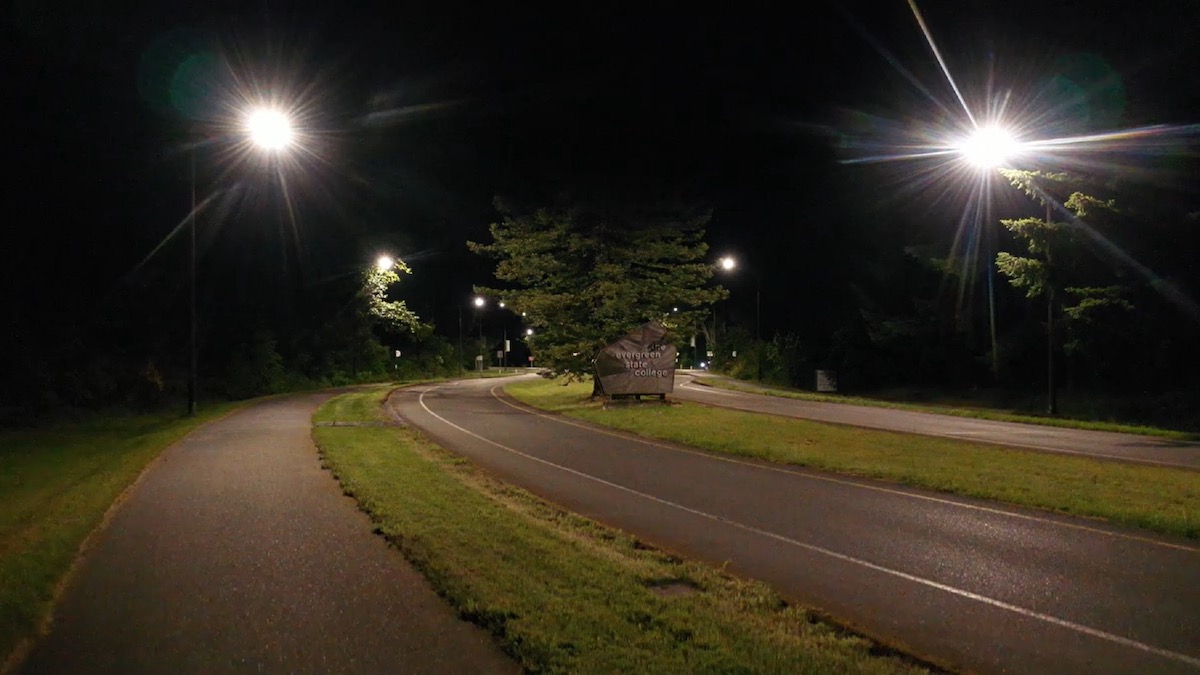18 Jun Installing LED Light Fixtures Dramatically Improves Roadway Lighting

Upgrading legacy roadway lighting with quality LED light fixtures can drastically improve roadway visibility and save energy. Cities, business parks, and school campuses in Western Washington are often nestled amongst evergreen forests and dense greenery. The result is a serene and idyllic environment during daytime use. These emerald oases transform into potentially precarious conditions for drivers, pedestrians, and wildlife at night. Poor light quality and low light levels contribute to this hazard. According to the National Safety Council, half of all traffic deaths occur during nighttime, even though it comprises only 25% of total driving. Drivers need to take extra precautions at night, such as: driving only when well rested, not driving under the influence, remaining alert even on familiar roads, and minimizing distractions such as cell phones. Transportation and roadway managers can help improve nighttime driving safety, too.
LED Roadway Lighting Best Choice
As transportation and roadway managers explore the possibility of upgrading their existing high-pressure sodium or metal halide, they review the pros and cons of that project. They are likely to reflect on their motivation for wanting to upgrade to LED. Do they want to reduce energy? Lower maintenance costs? Improve light levels? Or do they have other end goals in mind? LED solutions likely address all of those concerns.
- LED fixtures typically use less than half of the amount of energy as high-intensity discharge (HID) lighting
- Long run time hours of roadway fixtures maximize long term energy savings
- LED fixtures lower maintenance costs because LEDs last 2 to 4 times longer than metal halide or high-pressure sodium lamps
- Properly designed LED fixtures reduce light spill and glare
- LED fixtures have smart controls for maximum energy savings and maintenance monitoring
- Recent advances in LED technology allow a wide variety of color temperature choices, displacing blue-white light that garner so much criticism
Quality LED Roadway Fixture?
The LED lighting industry is rapidly changing and upgrading its products to enhance efficiency, longevity, and appearance. The industry now evaluates quality LED roadway fixtures based on criteria such as lumens per watt (lm/W), Kelvin color temperature (K), color rendering index (CRI), and BUG rating. Only a decade ago, LED fixtures were limited in wattage equivalence, color temperature, and glare mitigation. LED fixtures are now able to replace even the highest wattage fixtures including high mast area lights and sports lighting floods. The single option of blueish-white LED lights is a thing of the past. LED fixtures are available in your choice of Kelvin color temperatures ranging from warm, orangish-yellow 2200K to crisp, bluish-white 6500K, and multiple colors in between.
Improved lighting at The Evergreen State College is evident and astounding, safely and beautifully illuminating the parkway for visitors.
– Bobbi McLeod, LC, Lighting Designer, Lumenal Lighting
A successful LED roadway project depends upon BUG rating and light distribution. BUG rating measures back light, up light, and glare of an LED light fixtures. Too much back light could disturb properties adjacent to the roadway, specifically residential dwellings. Too much up light contributes to light pollution and may disrupt nature and health. LED fixtures with high glare create driver visual discomfort and make driving at night less safe. The effect of a good BUG rating is the quality of the light emitted from the fixture and how it impacts its surroundings.
Not only is the quality of lighting important to LED roadway projects, but where the light is directed is essential as well. Light distribution refers to where light concentrates coming from a fixture. Traditional light sources such as metal halide and high-pressure sodium lamps are woefully omnidirectional, meaning they just expand in every direction, regardless of what you are trying to illuminate. That creates a great deal of waste and forces designers to choose higher wattage lamps to ensure adequate roadway light levels. Conversely, LED fixtures are unidirectional and allow for concentration on a specific area. For example, in a straight roadway application, designers will choose an oblong, Type 3 distribution to cover the narrow roadway. Unidirectional LED light results in minimal spill behind the fixture or past the road on the other side. The aimable nature of LED fixtures allows for reduced wattage needs and decreased negative impact on the surrounding area.
Contact us online or call Lumenal Lighting at (425) 481-5001 today to start your LED Roadway Lighting Improvement Project.
Citations
- Lumenal Lighting – LED Street Lights and Area Lighting
- Lumenal Lighting – LED Commercial Lighting Upgrade Service
- The Evergreen State College – Evergreen
- GE current – Evolve® ERLH Series Cobra Head
- NADAR Drone Company – About Nadar Drone Imaging
- National Safety Council (NSC) – The Most Dangerous Time to Drive
Evergreen College LED Roadway Lighting Upgrade Project Video

